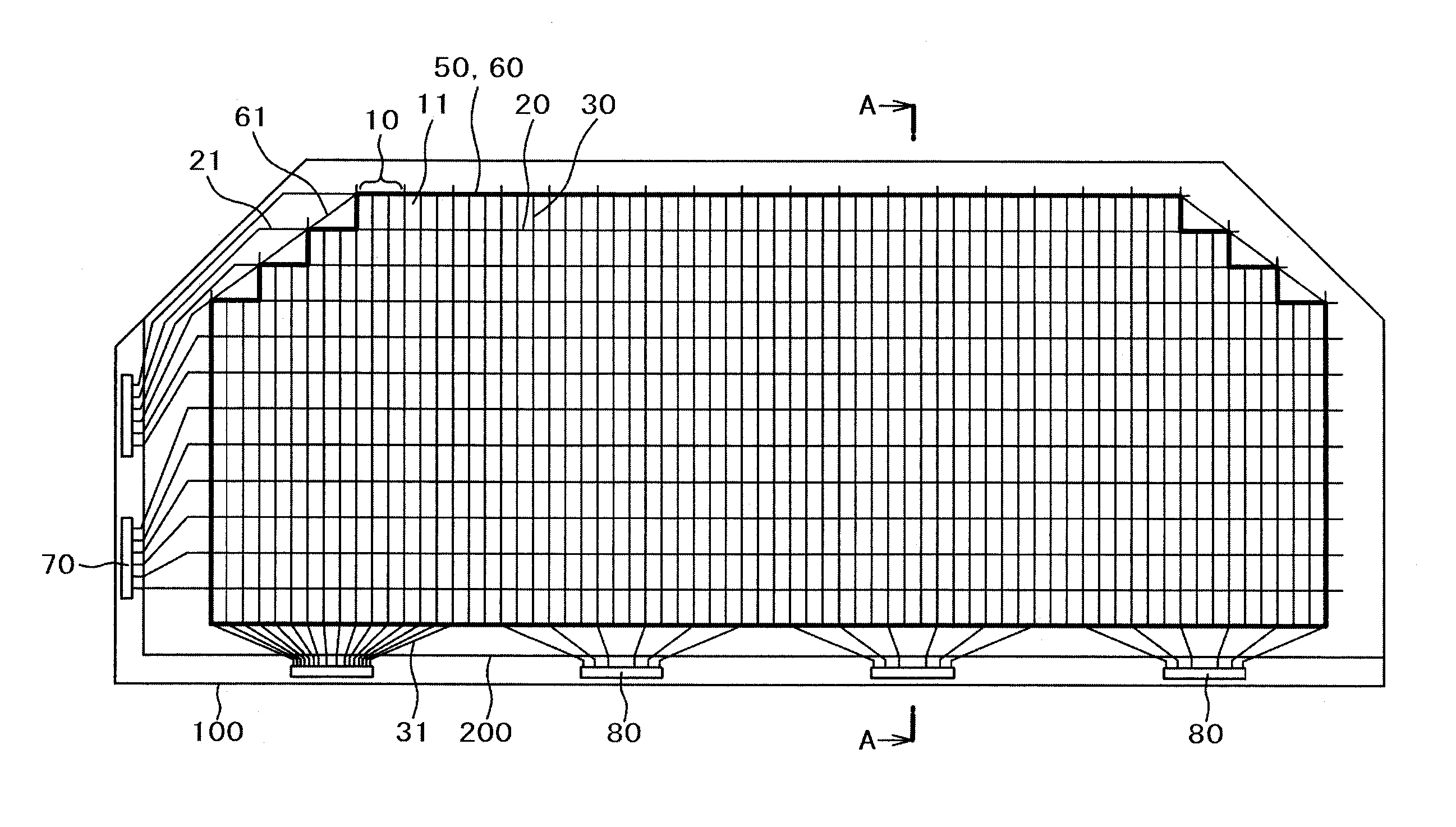Display device
a display device and display technology, applied in the field of display devices, can solve problems such as color shading, uniform luminance, and uniform luminance, and achieve the effect of preventing uniform luminance or color shading
- Summary
- Abstract
- Description
- Claims
- Application Information
AI Technical Summary
Benefits of technology
Problems solved by technology
Method used
Image
Examples
first embodiment
[0028]FIG. 1 is a plan view of a liquid crystal display device according to the present invention. The liquid crystal display device in FIG. 1 has a irregular hexagonal shape in which corners of a rectangle are cut-off. FIG. 2 is a cross-sectional view along line A-A in FIG. 1. In FIG. 1 or FIG. 2, a counter substrate 200 having color filters, etc. formed thereon is disposed over a TFT substrate 100 having pixels 10 formed in a matrix. A not illustrated liquid crystal layer is put between the TFT substrate 100 and the counter substrate 200.
[0029]In FIG. 1, the TFT substrate 100 is formed larger than the counter substrate 200, and gate drivers 70 for driving scanning lines 20 or source drivers 80 for driving video signal lines 30 are arranged at a portion in which the TRT substrate 100 is made larger than the counter substrate 200.
[0030]The scanning lines 20 are extended horizontally and arranged vertically in the display area 60. Further, the video signal lines 30 are extended verti...
second embodiment
[0047]FIG. 8 is a plan view for a corner cut-off portion in a liquid crystal display device showing a second embodiment of the invention. FIG. 8 is an enlarged plan view of a display area sloping portion 61 in FIG. 1. The configuration in FIG. 8 is identical with that in FIG. 3 of the first embodiment except that the number of the sub-pixels is decreased for every six on each side of the display area and for every 12 on both sides in the display area.
[0048]That is, in FIG. 8, n0, n1, n2, etc. represent each the number of sub-pixels 11 in the horizontal direction on each side of the display area. n0 is a number of the sub-pixels in a full size display area in the horizontal direction on each side of the display area. Accordingly, n0−n1=6, n1−n2=6, n3−n2=6, etc. are satisfied. The shape of the pixel 10 is identical with that in FIG. 4.
[0049]FIG. 9 is a view in which only the video signals 30 in FIG. 8 are extracted. In FIG. 9, 1 p shows video signal lines for 1 pixel. As shown in FIG....
third embodiment
[0051]In the first or second embodiment, the pixel 10 comprises the three sub-pixels 11 and the shape of the pixel 10 is square as shown in FIG. 4. In the case of the first or second embodiment, the angle of inclination θ for the display area sloping portion 61 is defined as tan−1(yp / xp) or 1 / 2 tan−1(hp / xp), etc. Accordingly, it is difficult to cope with various inclined angles θ in the display area.
[0052]In this embodiment, the invention can cope with optional angle of inclination θ in the display area by changing the shape of the pixel 10 or the shape of the sub-pixel 11 conforming to the angle of inclination θ in the display area. FIG. 10 is a plan view for a corner cut-off portion in a liquid crystal display device showing a third embodiment of the invention. FIG. 10 is an enlarged plan view of the display area sloping portion 61 in FIG. 1.
[0053]In FIG. 10, the sub-pixel is decreased for every three on each side of the display area in the same manner as for the first embodiment ...
PUM
 Login to View More
Login to View More Abstract
Description
Claims
Application Information
 Login to View More
Login to View More - R&D
- Intellectual Property
- Life Sciences
- Materials
- Tech Scout
- Unparalleled Data Quality
- Higher Quality Content
- 60% Fewer Hallucinations
Browse by: Latest US Patents, China's latest patents, Technical Efficacy Thesaurus, Application Domain, Technology Topic, Popular Technical Reports.
© 2025 PatSnap. All rights reserved.Legal|Privacy policy|Modern Slavery Act Transparency Statement|Sitemap|About US| Contact US: help@patsnap.com



